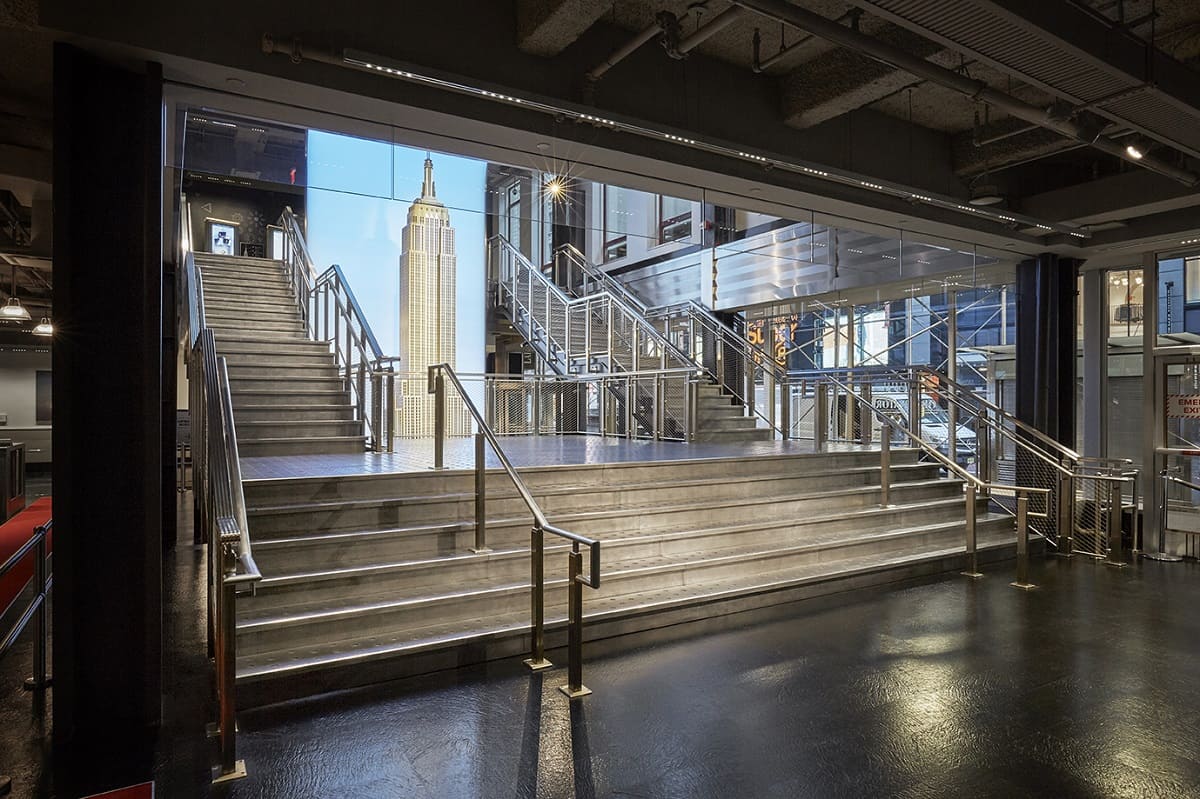

Articles
How Many Stairs In The Empire State Building
Modified: December 7, 2023
Discover fascinating articles discussing the Empire State Building's numerous stairs and delve into the architectural marvel of this historic landmark.
(Many of the links in this article redirect to a specific reviewed product. Your purchase of these products through affiliate links helps to generate commission for Storables.com, at no extra cost. Learn more)
Introduction
The Empire State Building, a towering icon of New York City, has captivated the imagination of millions around the world. Standing tall at 1,454 feet (443.2 meters), this architectural marvel has long been synonymous with the city’s grandeur and ambition. From its breathtaking views to its awe-inspiring design, the Empire State Building has left an indelible mark on the skyline of Manhattan.
But have you ever wondered how many stairs are hidden within the grandeur of this legendary structure? In this article, we will delve into the history, construction, and specifications of the Empire State Building, shedding light on the number of stairs it houses and their significance.
As we ascend the Empire State Building, let us embark on a journey that intertwines architecture, engineering, and human ingenuity to understand the role that stairs play in this iconic landmark.
Key Takeaways:
- The Empire State Building houses 1,576 stairs, serving as crucial emergency routes and promoting a healthier, active approach to vertical transportation, contributing to its iconic status.
- Maintaining the stairs presents unique challenges due to wear and tear, architectural intricacies, and the building’s popularity, showcasing the commitment to preserving this architectural marvel.
History of the Empire State Building
The idea of constructing a massive skyscraper in New York City was conceived in the 1920s. John Jacob Raskob, an influential businessman, and Al Smith, the governor of New York, sought to create a building that would symbolize the city’s dominance and economic prowess.
The construction of the Empire State Building began on March 17, 1930, and was completed in a remarkably short time of just over a year and a half. The project was overseen by general contractor Starrett Brothers and Eken, and the architectural firm Shreve, Lamb & Harmon.
During the Great Depression, the Empire State Building provided much-needed employment for thousands of workers. Its construction became a symbol of hope and progress during a time of economic hardship, showcasing the resilience and determination of the American spirit.
Upon its completion, the Empire State Building stood as the world’s tallest building, surpassing the height of the Chrysler Building. The grand opening took place on May 1, 1931, with President Herbert Hoover remotely turning on the building’s lights from Washington, D.C.
Since then, this iconic skyscraper has become a symbol of not just New York City but also the determination, innovation, and ambition of the United States as a whole. It has featured in countless movies, books, and works of art, solidifying its place in popular culture as a beacon of human achievement.
Construction of the Empire State Building
The construction of the Empire State Building was a testament to human ingenuity and engineering marvels of the time. The project was completed in an astonishingly short time, a remarkable feat considering the challenges faced during its construction.
The construction process involved an army of workers, with as many as 3,400 men laboring on-site at any given time. They worked diligently, day and night, to bring the Empire State Building to life.
One of the most significant advancements in the construction of the Empire State Building was the innovative use of the steel frame. This allowed the building to support its massive weight while also accommodating the architectural requirements of height and design.
The construction team used a total of 57,000 tons of steel to create the framework of the building. The steel beams were carefully assembled and riveted together to form the structure that would support the immense weight of the building and withstand the forces of wind and weather.
To further expedite the construction process, multiple floors were built simultaneously. This was made possible by dividing the building into sections, with each section constructed concurrently.
Furthermore, the project utilized advanced techniques like hydraulic rams and steam-powered hoists to lift materials to higher levels efficiently. These innovations significantly accelerated the construction timeline, ensuring the Empire State Building was completed on schedule.
The final touch of the construction process was the installation of the iconic antenna spire. This spire, made of stainless steel, not only added to the height of the building but also served as a crucial component for radio and television broadcasting.
Overall, the construction of the Empire State Building was a remarkable achievement that showcased the skill and dedication of the construction workers, architects, and engineers involved. It forever changed the skyline of New York City and set a new standard for skyscraper construction worldwide.
Specifications of the Empire State Building
The Empire State Building is not just a towering structure but a masterpiece of engineering and design. Its specifications highlight the scale and grandeur of this iconic landmark.
Height: The Empire State Building stands at a remarkable height of 1,454 feet (443.2 meters) from its base to the tip of its antenna. From its completion in 1931 until the completion of the North Tower of the World Trade Center in 1971, it held the title of the tallest building in the world.
Floors: The Empire State Building boasts a total of 102 floors, each offering breathtaking views of the city below. These floors house a myriad of offices, retail spaces, and observation decks that attract millions of visitors every year.
Construction Material: The framework of the Empire State Building is primarily made of steel. It utilized over 57,000 tons of steel to create a sturdy and stable structure capable of withstanding the forces of nature.
Lighting: At night, the Empire State Building becomes a beacon of light, illuminating the New York City skyline. Its lighting system consists of LED lights that can produce a wide range of vibrant colors and patterns to mark various occasions and celebrations.
Observation Decks: The Empire State Building offers two observation decks to visitors – one on the 86th floor and another on the 102nd floor. These decks provide breathtaking panoramic views of the city, offering a unique perspective of the bustling metropolis below.
Architectural Style: The Empire State Building is an excellent example of Art Deco architectural style. Its distinctive setbacks, spire, and intricate detailing reflect the elegance and sophistication of this iconic era.
Green Initiatives: In recent years, the Empire State Building has undertaken various sustainability initiatives to reduce its carbon footprint. These include energy-efficient lighting systems, recycling programs, and the installation of green roofs to promote biodiversity.
Overall, the specifications of the Empire State Building illustrate its remarkable stature, architectural significance, and contribution to the New York City skyline. It is not only a testament to human achievement but also a symbol of innovation, endurance, and the enduring spirit of the city that never sleeps.
Number of Floors in the Empire State Building
The Empire State Building, with its soaring height and imposing presence, houses a multitude of floors that serve a variety of purposes. These floors are a testament to the building’s architectural marvel and its status as an iconic landmark.
The Empire State Building consists of 102 floors in total, including its ground floor. These floors span a wide range of uses, accommodating commercial offices, retail spaces, and observation decks.
The lower floors of the Empire State Building primarily house retail spaces and various businesses, including popular restaurants, cafes, and shops. These floors provide a bustling and vibrant atmosphere, catering to the needs of tenants and visitors alike.
As we ascend higher, the Empire State Building encompasses a significant number of floors dedicated to commercial office spaces. The building has been home to numerous prestigious companies, with tenants ranging from law firms to financial institutions and media companies.
One of the major attractions of the Empire State Building is its observation decks. These decks, located on the 86th and 102nd floors, offer visitors unparalleled panoramic views of the New York City skyline. The 86th-floor observatory is open to the public year-round, while the 102nd-floor observation deck is typically used for special events and private functions.
Apart from the designated floors, the Empire State Building also offers several service floors that house essential infrastructure and utilities. These floors accommodate electrical systems, HVAC units, elevators, and machinery required to operate the building efficiently.
It is important to note that the number of floors in the Empire State Building may vary depending on how floors are counted. Some sources indicate that there are 102 floors, while others may count additional mezzanine or technical floors.
Regardless of the exact count, the Empire State Building’s extensive number of floors represents its stature as a bustling center of business, tourism, and architectural excellence.
The Empire State Building has 1,860 steps from the ground floor to the 102nd floor. If you’re planning to visit, be prepared for a challenging climb!
Read more: How To Build Stairs To Attic
Number of Stairs in the Empire State Building
The Empire State Building is not only known for its towering height and breathtaking views but also for the number of stairs hidden within its magnificent structure. These stairs serve as an essential means of vertical transportation, providing access to various levels of the building.
The Empire State Building contains a total of 1,576 stairs from the ground floor to the 102nd floor. These stairs are spread across different sections of the building, allowing occupants and visitors to navigate through the vast interior.
While the majority of people choose to take the elevator to reach their desired destination, the stairs remain a crucial alternative. They offer a way to bypass potential elevator wait times or provide an opportunity for those who prefer a more active approach to reaching their destination.
It’s worth noting that the stairs in the Empire State Building are not typically open for general use. They are primarily used by staff, emergency personnel, and during evacuation drills or emergencies.
The stairs in the Empire State Building are meticulously designed to meet safety standards and ensure efficient movement within the building. They are constructed with sturdy materials and provide handrails for support and stability as individuals ascend or descend.
The number of stairs in the Empire State Building can vary depending on how different sources count them. Some sources may include intermediate landings or sections that require a change in direction, while others may only count the main straight staircases. Therefore, the exact number of stairs may differ slightly.
While the stairs in the Empire State Building may not be a major tourist attraction, they play a crucial role in the building’s functionality and safety. They contribute to the efficient movement of people within the building and serve as a backup means of transportation in case of emergencies or other circumstances.
So, while visitors may not have the chance to climb the stairs of this iconic landmark, the knowledge of their existence adds to the appreciation of the Empire State Building’s overall design and infrastructure.
Importance of Stairs in the Empire State Building
Although often overlooked, the stairs within the Empire State Building serve a vital role in its functionality and safety. While elevators are the primary mode of vertical transportation for most occupants and visitors, the inclusion of well-designed stairs is crucial for several reasons.
First and foremost, stairs are an essential element of emergency evacuation plans. In the event of a fire, power outage, or other emergencies, elevators may become inoperable or unsafe to use. The stairs provide a reliable and efficient means of evacuating occupants from the building swiftly and safely. Additionally, stairwells are designed to offer fire-resistant escape routes, further enhancing their importance in emergency situations.
Moreover, stairs offer an alternative option for vertical transportation in everyday scenarios. While elevators are often the preferred choice for convenience and speed, stairs can provide an active and healthier option for those who choose to incorporate physical activity into their daily routines. Taking the stairs also helps alleviate elevator congestion during peak times and reduces energy consumption, contributing to a more sustainable and efficient operation of the building.
The inclusion of well-designed stairs within the Empire State Building also promotes a sense of interconnectedness and accessibility. By providing multiple options for vertical movement, the building ensures that occupants and visitors have the flexibility to choose the mode of transportation that suits their needs and preferences. This inclusivity promotes a more seamless and enjoyable experience within the building.
Beyond their functional significance, the stairs in the Empire State Building also contribute to the overall architectural design and aesthetic appeal. From the elegant handrails to the intricate detailing, these stairs add a touch of grandeur to the interior of the building, enhancing its visual appeal and providing a sense of exploration as individuals traverse through different levels.
The importance of stairs within the Empire State Building extends beyond their practical and aesthetic aspects. They symbolize accessibility, resilience, and preparedness in emergency situations. By including well-designed and well-maintained staircases, the Empire State Building demonstrates its commitment to the safety and well-being of its occupants.
While visitors may not have the opportunity to ascend the stairs of this iconic landmark, their presence serves as a reminder of the building’s comprehensive design and dedication to ensuring a safe, efficient, and inclusive environment for all who enter its magnificent doors.
Challenges of Maintaining Stairs in the Empire State Building
Maintaining the stairs within the Empire State Building presents a unique set of challenges due to the sheer size and complexity of the building. The ongoing preservation and upkeep of these essential vertical pathways require careful attention and expertise.
One of the primary challenges faced in maintaining the stairs is the consistent wear and tear caused by the large number of people traversing them daily. The constant foot traffic can lead to gradual deterioration of the steps, handrails, and other structural components. Ensuring the structural integrity of the stairs requires regular inspections, repairs, and replacements as needed.
Moreover, the height of the Empire State Building poses logistical challenges in terms of accessibility for maintenance personnel and equipment. The vertical nature of the building necessitates the use of specialized equipment, such as scaffolding, cranes, and lifts, to reach different levels for inspection and repairs. Coordinating these efforts while minimizing disruption to the occupants and visitors of the building requires careful planning and coordination.
The Empire State Building has a unique architectural design, which means that each stairwell may have distinct characteristics and features that need to be considered during maintenance. The specific design elements, such as ornate railings or intricate detailing, require specialized care to preserve their aesthetic appeal while ensuring their functionality and safety.
Ensuring compliance with safety regulations and building codes is another challenge when maintaining the stairs. Regular inspections and assessments must be conducted to identify any potential hazards or non-compliance issues. This includes ensuring proper lighting, handrails, non-slip surfaces, and fire-resistant materials in accordance with building codes and safety standards.
Additionally, the Empire State Building’s status as a popular tourist attraction presents additional challenges in maintaining the stairs. The constant flow of visitors means that the stairs are subject to higher levels of use and potential damage. Implementing crowd management strategies and preventative maintenance measures is crucial to sustain the integrity of the stairs while minimizing any disruption to the visitor experience.
Despite these challenges, the Empire State Building is committed to ensuring the long-term preservation and maintenance of its stairs. The building management team, along with skilled maintenance personnel, employ rigorous protocols to address these challenges proactively. By conducting regular inspections, prompt repairs, and utilizing specialized techniques, they continuously strive to maintain the stairwells’ functionality, safety, and aesthetic appeal.
The commitment to preserving the stairs within the Empire State Building showcases the building’s dedication to providing a world-class experience for its occupants and visitors, while ensuring the continued integrity and longevity of this iconic landmark.
Conclusion
The Empire State Building stands tall as a testament to human ingenuity, architectural excellence, and the spirit of New York City. From its historic construction to its remarkable specifications, this iconic landmark continues to capture the imagination of people from around the world.
Throughout this article, we have explored various facets of the Empire State Building, including its history, construction, specifications, number of floors, and the importance of its stairs. Each element contributes to the building’s unique character and lasting legacy.
The Empire State Building’s rich history and rapid construction during the Great Depression reflect the resilience and determination of the American people. Its innovative design, incorporating steel frameworks and advanced construction techniques, set new standards in skyscraper engineering.
The remarkable specifications of the Empire State Building, from its towering height to the number of floors, emphasize its significance on the New York City skyline. It serves as a symbol of the city’s prominence and ambition, daring to reach new heights.
The inclusion of stairs within the Empire State Building plays a crucial role in providing vertical transportation, emergency evacuation routes, and promoting a healthier and more active approach to navigating the building.
Maintaining the stairs within the Empire State Building is a complex task, requiring careful attention to structural integrity, adherence to safety standards, and coordination of maintenance efforts with minimal disruption to occupants and visitors.
In conclusion, the Empire State Building stands as a testament to human achievement, architectural marvel, and the enduring spirit of New York City. Its history, construction, specifications, and the importance of its stairs converge to create an unforgettable experience for all who have the privilege to visit this iconic landmark.
As we marvel at the Empire State Building’s majestic presence, let us remember the dedication, vision, and remarkable engineering that went into creating this symbol of human ambition and progress.
Frequently Asked Questions about How Many Stairs In The Empire State Building
Was this page helpful?
At Storables.com, we guarantee accurate and reliable information. Our content, validated by Expert Board Contributors, is crafted following stringent Editorial Policies. We're committed to providing you with well-researched, expert-backed insights for all your informational needs.















0 thoughts on “How Many Stairs In The Empire State Building”